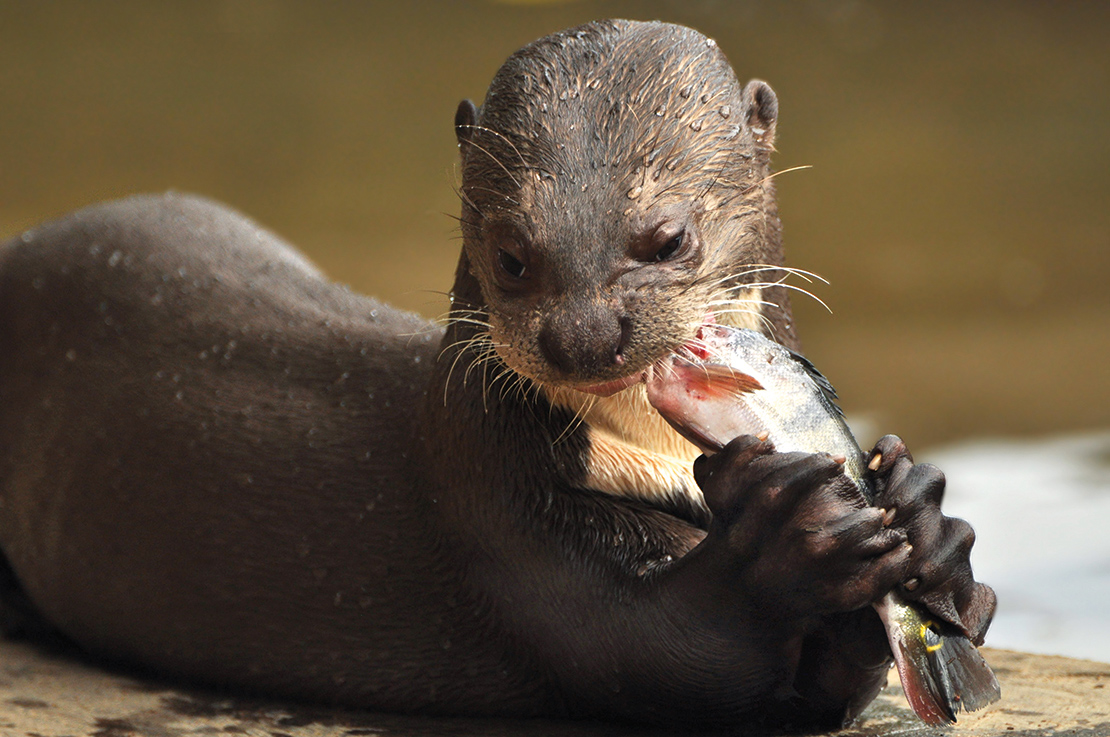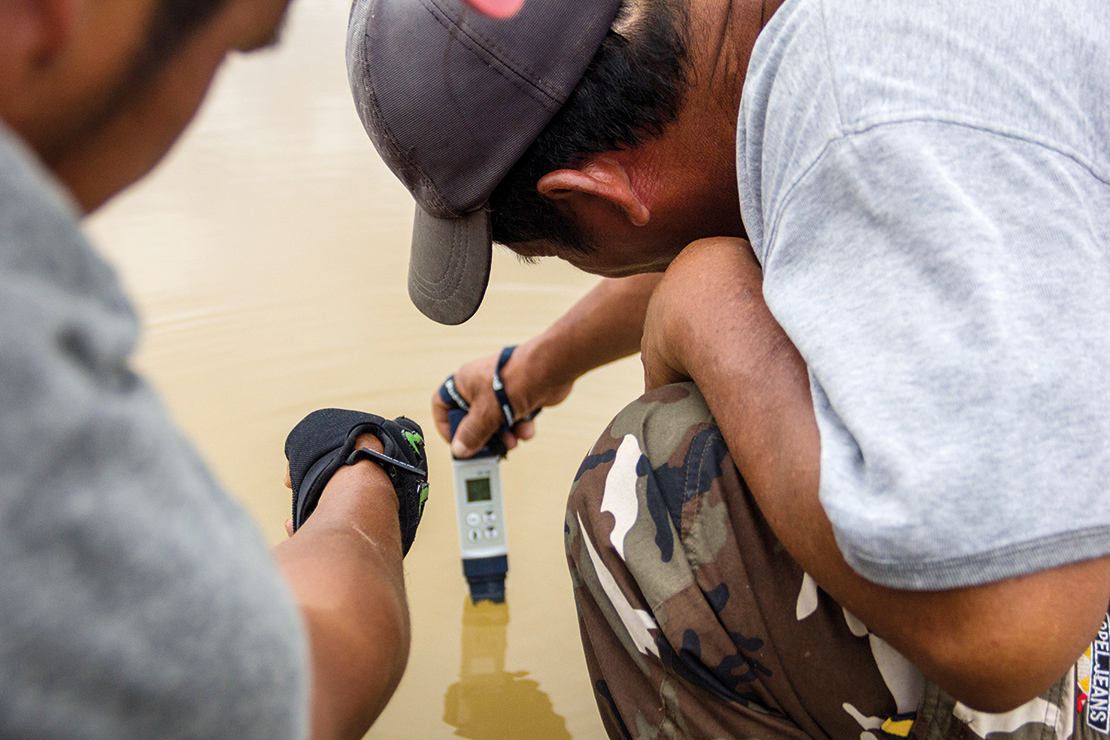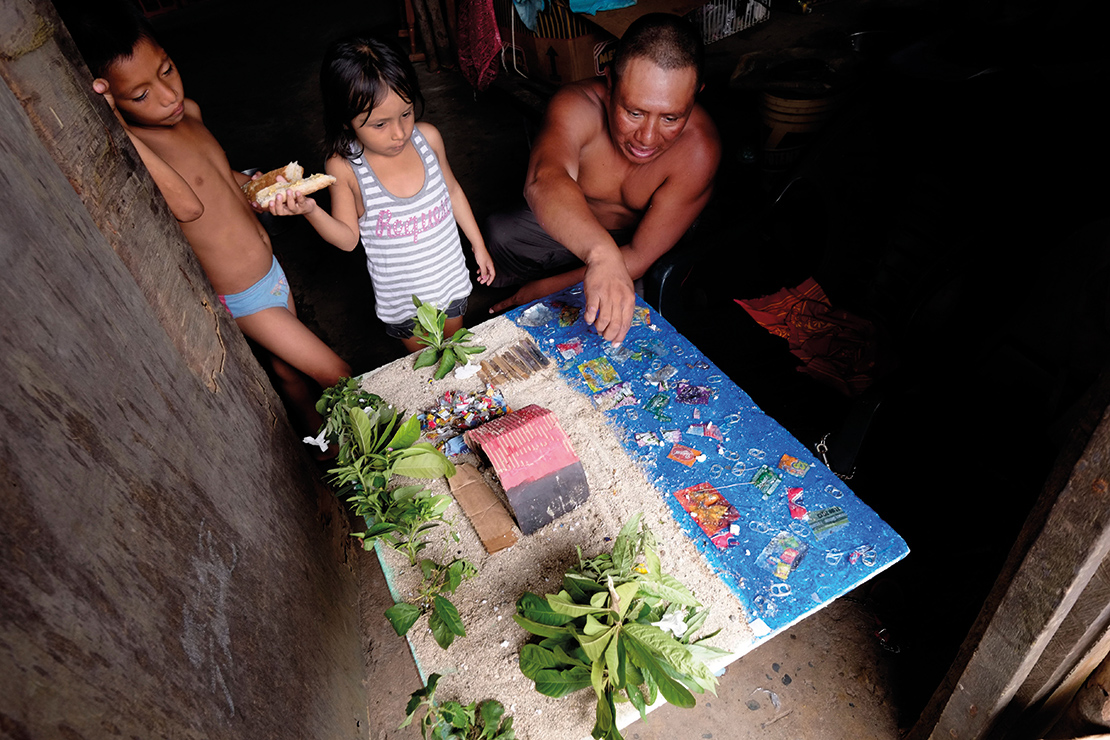
Target 8: Pollution reduced
By 2020, pollution, including from excess nutrients, has been brought to levels that are not detrimental to ecosystem function and biodiversity.
Key messages
- Because of their high dependence on nature, IPLCs are particularly vulnerable to the impacts of pollution and continue to suffer disproportionately from its effects.
- IPLCs have knowledge systems and practices, beliefs and customary laws aligned with protecting nature and preventing pollution; their communities are monitoring and reducing pollution on the ground and limiting chemical use.
- Links with international campaigns and external support for pollution-related complaints and legal challenges have empowered some IPLCs in combating pollution.
- However, the full potential contribution of IPLCs remains largely unrealised, and requires greater governmental support, including through strengthened laws and regulations.
Significance of Target 8 for IPLCs
Pollution is the largest environmental cause of disease and death in the world today and is responsible for an estimated nine million premature deaths each year. IPLCs are highly vulnerable to the impacts of pollution, given their close links to the local environment, their relative poverty, and their history of colonial displacement and discrimination. They also continue to suffer disproportionately from pollution’s effects, often lacking the power to prevent external activities from polluting their lands and waterways.1
Documented cases of the effects of pollution on IPLCs include cases related to persistent organic pollutants; to organochlorines such as PCBs; to lead exposure, and to mercury.2 There is a growing body of evidence that women’s reproductive health is uniquely affected by exposure to environmental toxins;3 and research has also shown that Navajo women in the USA exposed to uranium contamination can pass on the exposure to their foetus.4 Indigenous women in Alaska measured comparatively high levels of persistent organic pollutants in their breast milk, at levels that were considered unsafe.5
The contamination of traditional lands and territories can have major impacts on the social, economic, political and cultural fabric of IPLCs. For example, pollution can lead to a fear of consuming traditional wild foods and foster increased reliance on nutrient-poor and expensive market foods, increasing the risk of malnutrition and chronic diseases. Similarly, fears about environmental contamination can lead to a decline in the use of traditional remedies, as has been documented among the Mohawk of North America,6 resulting in worsening health conditions. Therefore, for IPLCs, understandably, pollution levels are of great concern.

Polluted waterways also impact on local biodiversity, such as giant otter, which now only live in Guyana. Credit: Elizaveta Kirina.
Contributions and experiences of IPLCs towards Target 8
IPLCs are making significant contributions to reducing environmental pollution through actions on the ground and through participation in local, national and international policy processes. In terms of actions on the ground, community-based monitoring systems have emerged as a valid and cost-effective component in pollution control. For example:
- Since 2016, indigenous reindeer herders and fishermen in the Arctic region of North Yakutia, Russia, have been monitoring river pollution, particularly for coal dust and other industrial and biological contaminants. In October 2018, high levels of pollution were recorded in the River Viluy. Since then, local indigenous communities have established their own analytical laboratory, and this has empowered them in dialogues with the Zhigansky district administration and relevant mining companies.
- In Guyana, the Wapichan have undertaken a monitoring project to limit the damage done by miners (see Box 15), and this has led them to securing government support for protecting their lands and environment against further pollution. This approach is also being applied by other indigenous peoples, including the Achuar in the Peruvian Amazon (in relation to pollution from oil extraction)7 and the Akwesasne Mohawks in Canada and the USA (in relation to the health consequences of environmental contamination).8
Box 15
There is evidence of illegal gold mining at this creek near Parabara Village, where monitors test water quality. The surrounding forest has been cut down in the past five years and the water is no longer safe to drink. Credit: Vicki Brown.

Case study: Wapichan Monitoring Programme, Guyana9
The South Rupununi District Council (SRDC), the representative institution of the mostly Wapichan indigenous people in Guyana, established a monitoring programme in 2013 focusing partly on mining activities. The SRDC monitors use handheld GPS sets, smartphones and drones to gather data, and report back to the village councils and the SRDC.
— Read the full case study
Like the Wapichan, many other communities are opposing pollution on their lands from mining and hydrocarbon extraction:
- In Australia, the local Mirrar people in the Kakadu area compelled mining company Rio Tinto to shelve plans for the Jabiluka uranium mine, primarily because of pollution concerns.10 At nearby Koongarra, traditional owner and sole surviving member of the indigenous Djok clan rejected compelling offers from uranium miner Areva for his ancestral land, instead pledging it to the Australian Government to become part of the World Heritage-listed Kakadu National Park.11
- In Colombia, the indigenous peoples of the Resguardo Canamomo Lomaprieta mounted and won a court case for the delimitation and titling of their lands, based on their concerns about pollution from gold mining. All further mining permits or formalisation of mining activities were to be suspended during this time.12
- In Ecuador, the Waorani people won a landmark legal case against the Ecuadorean Government, suspending any possibility of selling the community’s land for oil exploration without a free, prior and informed consultation process.13
- In Papua New Guinea, concerns about the potential environmental damage caused by a proposed deep-sea mining project led by Canadian mining company Nautilus Minerals has united coastal communities to form the Alliance of Solwara Warriors. Together they have mobilised local opposition, providing education on the potential impacts, and participated in court cases which have, so far, left the mining company unable to proceed.14
Several pollution-related cases raised by IPLCs have been moved to the home jurisdiction of the companies responsible for the pollution, or have become cases submitted to international complaints mechanisms. Examples include longstanding legal battles against Chevron (formerly Texaco) for the environmental impacts of its operations in the Oriente region of Ecuador, which have included variously a class action lawsuit in the US federal court, international arbitration, and even proceedings in Canada.15
IPLCs have also made complaints focusing on pollution under the OECD Guidelines for Multinational Enterprises. For example, communities in Cameroon have alleged that UK company Victoria Oil and Gas polluted their waterways,16 and a case has been brought against Credit Suisse in Switzerland on behalf of indigenous communities for failing to carry out risk-based and human rights due diligence in connection to the North Dakota Access Pipeline in the USA.17

Doing beach clean-ups by kayak in Antigua and Barbuda. Credit: Adopt a Coastline.
At the international level, IPLCs have contributed to the Convention on Biological Diversity, the Stockholm Convention on Persistent Organic Pollutants, and the Minamata Convention on Mercury.18 In addition, the ‘Initiative for Responsible Mining Assurance’ has IPLC representation on its steering committee,19 and the ‘Aluminium Stewardship Initiative’ has an Indigenous Peoples’ Advisory Forum.20
In other cases, communities are working directly to clean up pollution, reduce their own chemical impacts, and develop or contribute to local or regional plans for pollution control and waste management:
- In Antigua and Barbuda, the ‘Adopt a Coastline’ project has become a national movement involving local community actions to clean up beach pollution (see Box 16).
- In Panama, the Guna people have developed ways of monitoring and managing waste to reduce pollution from plastics and other forms of waste (see Box 17).
- Many indigenous groups have participated in Canada’s Arctic Environmental Strategy to include a Northern Contaminants Program; others have minimised pollution via extractive industry ‘impact benefit agreements’, or have participated in pollution assessments.21
- More broadly, many indigenous communities maintain traditional agricultural practices, which make minimal use of agrochemicals and rely on natural pest control.22
Box 16: Jennifer Moranto, Adopt a Coastline
Case study: Communities tackle beach pollution in Antigua and Barbuda
The ‘Adopt a Coastline’ initiative is changing the attitudes and behaviour of local children through fostering and mentoring youth stewards to conserve and protect the marine and coastal assets in Antigua and Barbuda.
— Read the full case study
Box 17: Jorge Andreve and Onel Masardule, Foundation for the Promotion of Indigenous Knowledge, Guna Indigenous Peoples
A Guna Yala man explains how waste is negatively impacting water quality. Credit: Eddie Gerald.

Case study: Reducing and reusing waste in the Guna Yala region, Panama
In recent decades, waste, especially plastic waste, has been accumulating in every corner of Panama’s Guna Yala region. Waste pollution has been recognised as one of the greatest threats to the biological diversity of the Caribbean.
The Guna people accept our responsibilities for the generation of waste and have given ourselves the task of finding simple, rapid, low-cost measures to deal with it.
— Read the full case study
Opportunities and recommended actions
- IPLCs should mobilise collective actions to tackle pollution, including through community-based monitoring systems based on cultural, health and ecosystem-based indicators, in conjunction with relevant national and global monitoring and reporting systems.
- Governments and relevant institutions should establish mechanisms that enable IPLCs to fully and effectively participate in policy and decision-making processes, upholding their knowledge and experiences. This includes SDGs 6 and 12, the Minamata Convention on Mercury, the Stockholm Convention on Persistent Organic Pollutants, and the UN Environment Programme’s Strategic Approach to International Chemicals Management.
- Governments should strengthen local and national institutions to ensure polluting industries are accountable and to accelerate the development of clean energy sources and clean technologies that will ultimately prevent pollution at source.
- All actors should foster cultural values and behaviour upholding minimal waste and pollution.
Key resources
- Fernández-Llamazares, Á., Garteizgogeascoa, M., Basu, N., Brondizio, E.S., Cabeza, M., Martínez-Alier, J., McElwee, P. and Reyes-García, V. (2020) ‘A state-of-the-art review of indigenous peoples and environmental pollution’, Integrated Environmental Assessment and Management. Available at: https://doi.org/10.1002/ieam.4239
- Gracey, M. and King, M. (2009) ‘Indigenous health Part 1: Determinants and disease patterns’, The Lancet 374(9683), pp. 65-75.
- Jiménez, A., Cortobius, M. and Kjellén, M. (2014) ‘Water, sanitation and hygiene and indigenous peoples: A review of the literature’, Water International 39(3), pp.277–293.
References
- Fernández-Llamazares, Á., Garteizgogeascoa, M., Basu, N., Brondizio, E.S., Cabeza, M., Martínez-Alier, J., McElwee, P. and Reyes-García, V. (2020) ‘A state-of-the-art review of indigenous peoples and environmental pollution’, Integrated Environmental Assessment and Management. Available at: https://doi.org/10.1002/ieam.4239.
—
Global Alliance on Health and Pollution (2017) The Lancet Commission on Pollution and Health. London: The Lancet. Available at: https://www.thelancet.com/commissions/pollution-and-health
—
Jiménez, A., Cortobius, M. and Kjellén, M. (2014) ‘Water, sanitation and hygiene and indigenous peoples: a review of the literature’, Water International 39(3), pp.277–293. - Dallaire, F., Dewailly, É., Muckle, G., and Ayotte, P. (2003) ‘Time trends of persistent organic pollutants and heavy metals in umbilical cord blood of Inuit infants born in Nunavik (Québec, Canada) between 1994 and 2001’, Environmental Health Perspectives 111(13), pp. 1660-1664.
—
Arctic Monitoring & Assessment Programme (2015) AMAP Assessment 2015: Human health in the Arctic. Oslo: Arctic Monitoring & Assessment Programme. Available at: https://www.amap.no/documents/doc/amap-assessment-2015-human-health-in-the-arctic/1346
—
Anticona, C., San Sebastian, M. (2014) ‘Anemia and malnutrition in indigenous children and adolescents of the Peruvian Amazon in a context of lead exposure: A cross-sectional study’, Global Health Action 7.
—
Wheatley, B., Wheatley, M. A. (2000) ‘Methylmercury and the health of indigenous peoples: A risk management challenge for physical and social sciences and for public health policy’, Science of the Total Environment 259(1-3), pp. 23-29.
—
Gracey, M. and King, M. (2009) ‘Indigenous health Part 1: Determinants and disease patterns’, The Lancet 374(9683), pp. 65-75. - Godduhn, A. and Duffy, L. K. (2003) ‘Multi-generation health risks of persistent organic pollution in the far north: Use of the precautionary approach in the Stockholm Convention’, Environmental Science & Policy 6(4), pp. 341-353.
—
Lewis, J., Hoover, J., and MacKenzie. D. (2017) ‘Mining and environmental health disparities in Native American communities’, Current Environmental Health Reports 4, pp. 130-141. - Agency for Toxic Substances and Disease Registry (2015) Navajo birth cohort study. Agency for Toxic Substances and Disease Registry. Available at: https://www.atsdr.cdc.gov/sites/navajo_birth_cohort_study/
- Carmen, A. and Waghiyi, V. (2012) ‘Indigenous women and environmental violence: A rights-based approach addressing impacts of environmental contamination on indigenous women, girls and future generations’. Submission to the United Nations Permanent Forum on Indigenous Issues Expert Group Meeting, ‘Combatting Violence Against Indigenous Women and Girls.’ Available at: https://www.un.org/esa/socdev/unpfii/documents/EGM12_carmen_waghiyi.pdf
- Turner, N.J. and Turner, K. L. (2008) ‘“Where our women used to get the food”: cumulative effects and loss of ethnobotanical knowledge and practice; case study from coastal British Columbia’, Botany 86(2).
—
Howard, B. V., Lee, E. T., et al. (1999) ‘Rising tide of cardiovascular disease in American Indians. The Strong Heart Study’, Circulation 99(18).
—
Arquette, M., Cole, M., Cook, K., LaFrance, B., Peters, M., Ransom, J., Sargent, E., Smoke, V. and Stairs, A. (2002) ‘Holistic risk-based environmental decision making: A native perspective’, Environmental Health Perspectives 110(2). - Collyns, D. (2017) ‘After years of toxic oil spills, Indigenous Peruvians use tech to fight back’. The Guardian. London: The Guardian. Available at: https://www.theguardian.com/world/2017/dec/14/after-years-of-toxic-oil-spills-indigenous-peruvians-use-tech-to-fight-back
- Schell, L.M., Ravenscroft, J., Cole, M., Jacobs, A., and Newman, J. (2005) ‘Health disparities and toxicant exposure of Akwesasne Mohawk young adults: A partnership approach to research’, Environment Health Perspectives 113(12), pp. 1826-1832.
- South Rupununi District Council (2018) ‘Wapichan Environmental Monitoring Report’. South Rupununi District Council. Available at: http://wapichanao.communitylands.org/1548691773093-wapichan-environmental-monitoring-report-2018-v2.pdf
- Australian Conservation Foundation (2016) We stood with the Mirarr People to stop the Jabiluka Uranium Mine. Fitzroy: Australian Conservation Foundation. Available at: https://www.acf.org.au/jabiluka
- Disko, S. (2018) Jeffrey Lee saved Koongarra from uranium mining. Takoma Park: Beyond Nuclear International. Available at: https://beyondnuclearinternational.org/2018/06/10/jeffrey-lee-saved-koongarra-from-uranium-mining/
- See Target 15 for details of further developments in the Resguardo Canamomo Lomaprieta
—
Forest Peoples Programme (2017) ‘Groundbreaking win for indigenous people in Colombia’. Moreton-in-Marsh: Forest Peoples Programme. Available at: https://www.forestpeoples.org/en/rights-land-natural-resources-extractive-industries/press-release/2017/groundbreaking-win - Brown, K. (2019) ‘Indigenous Waorani win landmark legal case against Ecuador Gov’t’. Al Jazeera. Available at: https://www.aljazeera.com/news/2019/04/indigenous-waorani-win-landmark-legal-case-ecuador-gov-190426221504952.html
- Deep Sea Mining Campaign (2019) ‘Joint letter calling for the PNG Government to cancel all Nautilus Minerals deep sea mining licences’ Washington D.C.: Deep Sea Mining Campaign. Available at: http://www.deepseaminingoutofourdepth.org/joint-letter-calling-for-the-papua-new-guinea-government-to-cancel-all-nautilus-minerals-deep-sea-mining-licences-and-to-ban-seabed-mining-in-png/
- Business & Human Rights Resource Centre (2016) ‘Texaco/Chevron Lawsuits (re Ecuador)’. London: Business & Human Rights Resource Centre. Available at: http://business-humanrights.org/en/texacochevron-lawsuits-re-ecuador
- OECD Watch (2018) ‘Cameroon Communities vs. Victoria Oil and Gas’. Amsterdam: OECD Watch. Available at: https://complaints.oecdwatch.org/cases/Case_498
- OECD Watch (2017) ‘Society for Threatened Peoples vs. Credit Suisse’. Amsterdam: OECD Watch. Available at: https://complaints.oecdwatch.org/cases/Case_475
- International Indian Treaty Council (2016) ‘UN Minamata Convention on Mercury Intergovernmental Negotiating Committee Session 7, Intervention on Agenda Item 12’. San Francisco: International Indian Treaty Council. Available at: https://www.iitc.org/wp-content/uploads/Minamata-INC7-IITC-Intervention_web-.pdf.
- Initiative for Responsible Mining Assurance (2019) Governance. Port Townsend: Initiative for Responsible Mining Assurance. Available at: https://responsiblemining.net/about/governance/
- Aluminium Stewardship Initiative (2019) Aluminium Stewardship Initiative: Indigenous Peoples Advisory Forum. Aluminium Stewardship Initiative. Available at: https://aluminium-stewardship.org/about-asi/indigenous-peoples/
- Selin, H. and Selin, N. E. (2008) ‘Indigenous peoples in international environmental cooperation: Arctic management of hazardous substances’, Review of European Community & International Environmental Law 17(1), pp. 72-83.
—
Wright, L. and White, J. P. (2012) ‘Developing oil and gas resources on or near indigenous lands in Canada: An overview of laws, treaties, regulations and agreements’, International Indigenous Policy Journal 3(2).
—
Burger, J., Gochfeld, M. and Pletnikoff, K. (2009) ‘Collaboration versus communication: The Department of Energy’s Amchitka Island and the Aleut Community’, Environmental Research 109(4). - Wezel, A., Casagrande, M., Celette, F., Vian, J. F., Ferrer, A. and Peignè J. (2014) ‘Agroecological practices for sustainable agriculture. A review’, Agronomy for Sustainable Development 34, pp. 1-20.
—
Malmer, P., Tengö, M., et al. (2019) ‘Dialogue across Indigenous, local and scientific knowledge systems reflecting on the IPBES Assessment on Pollinators, Pollination and Food Production’. Stockholm: SwedBio. Available at: https://swed.bio/wp-content/uploads/2019/04/IPBES-7-Pollinators-poster_2019-04-24_144752.pdf


